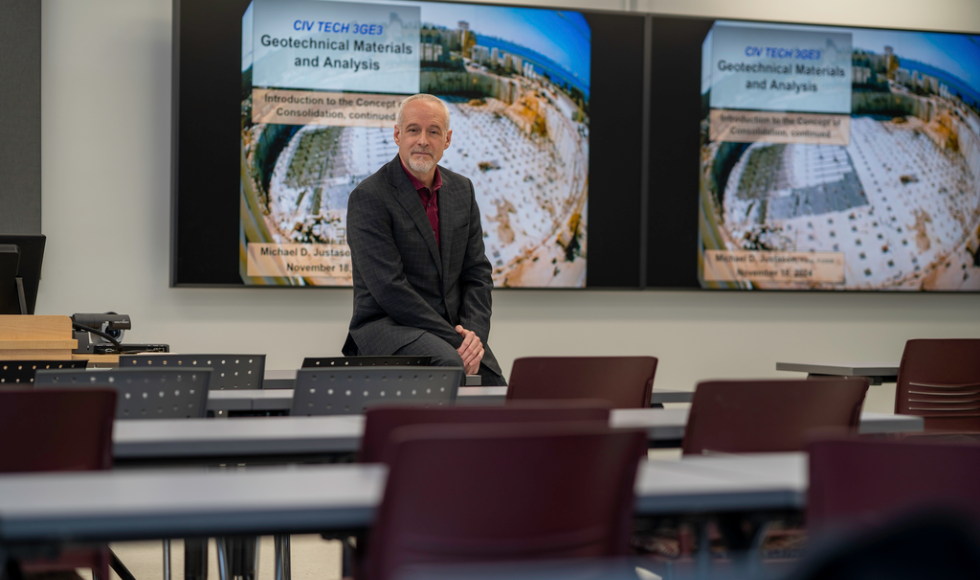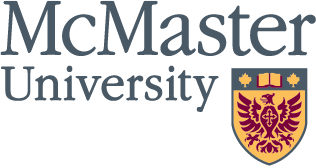Digital learning: In the hybrid classroom, tech meets teaching — and enhances it

Assistant Professor Mike Justason teaches in KTH-104, where tracking cameras and smart microphones create an immersive experience for remote students.
On a fall evening in McMaster’s Kenneth Taylor Hall (KTH 104), instructor Mike Justason faced a group of 18 engineering students — some in person, others tuning in from home. As he displayed his handwritten lecture notes using a digital tablet, a student’s voice suddenly echoed through the classroom. It wasn’t one of the students seated nearby — it was someone on Zoom, unmuted and engaged.
At first, the voice startled him. “It was a little freaky,” Justason admits. But soon, those remote contributions became part of the rhythm. With cameras tracking his movements and ceiling microphones picking up questions from anywhere in the room, the class felt more like a collaborative studio than a lecture hall.
“It really became a shared space,” said Justason, program chair and assistant professor of Civil Engineering Infrastructure Technology.
“The in-person students helped monitor the chat and supported their peers online. It was more interactive and engaging than I expected — for all of us.”
The room he taught in is part of a larger transformation underway at McMaster, driven by the Digital Learning Strategic Framework (DLSF) — a campus-wide effort to enhance and support digital learning in ways that are inclusive, accessible, and responsive to student needs.
A strategic vision takes shape
Launched in May 2023 by the Office of the Vice-Provost, Teaching and Learning (OVPTL) as part of the Partnered in Teaching and Learning Strategy, the DLSF guides McMaster’s digital education priorities. It emphasizes collaboration, innovation and alignment with initiatives like the Accessibility Roadmap, the Generative AI Task Force, and open educational resource (OER) advocacy.
Earlier this year, an implementation team was appointed to bring the DLSF’s goals to life:
- Ilana Bayer, academic director, DLSF, OVPTL and assistant professor, Faculty of Health Sciences
- Joanne Kehoe, manager, DLSF, OVPTL
- Lisa Dyce, educational developer, DLSF, OVPTL
- Paige Maylott, project coordinator, DLSF, OVPTL
- Supriya Bains, project support assistant, DLSF, OVPTL
The team is charged with identifying and supporting projects that exemplify the DLSF’s commitments — and invites the McMaster community to do the same via an open submission form.
“Our work is about more than new tech or platforms,” says Bayer. “We want to cultivate a culture where digital learning enriches teaching and empowers students — and where that work is shared, celebrated, and continuously improved.”
The team is also hosting Connect and Co-Create: Shaping the Future of Digital Learning at McMaster, a hybrid event as part of McMaster’s Teaching and Learning Month this May. The event is on Monday, May 26, 2025 from 11 a.m. to 1 p.m. in KTH-104, or online, with a pizza lunch for in-person attendees.
Projects with impact
Since its launch, the DLSF has supported a range of initiatives, from reimagining classroom spaces to expanding access to open learning resources. One example is the Online Learning Fellows program led by Lisa Dyce, which helps instructors redesign or create new courses specifically for online delivery.
Currently, 16 instructors from four different Faculties are participating, with a new cohort joining this month. By helping faculty improve the quality and availability of online courses during these critical terms, the program helps students stay on track — and stay at McMaster — throughout the year.
“The program is designed to give faculty the time, support, and community they need to thoughtfully design online courses that reflect best practices in pedagogy and digital learning,” says Dyce. “Ultimately, it’s about supporting student success through intentional, high-quality course design.”
Other faculty are seeing equally transformative results through McMaster’s Open Educational Resources (OER) Grant Program, which is open for applications and has saved students an estimated $1 million in course materials since 2020.
Felicia Vulcu, an associate professor and member of the OER committee, has supported the program since its early days.
“What I love about OER is that it empowers creativity and collaboration,” she says. “We’ve seen projects at McMaster across all disciplines — from interactive e-books, lab manuals to virtual field trips — and the momentum keeps growing.”
One standout OER is Foundations of Human Anatomy, created by Yasmeen Mezil, an assistant professor in the Department of Pathology and Molecular Medicine, and a team of undergraduate students. Designed as an introductory anatomy manual, the interactive resource is built by students, for students, and available to learners worldwide.
“Our goal was to create something approachable and empowering,” says Mezil. “Students contributed as writers, illustrators, and co-creators. They gained real experience — and helped make anatomy more accessible to others.”
Student-centred from the start
The DLSF also prioritizes student perspectives, especially in emerging areas like generative AI. A recent project, Undergraduate Student Perspectives on Generative Artificial Intelligence at McMaster, led by student partner Samarah Maqbool gathered insights from more than 1,300 undergraduates about how AI is shaping their learning.
“Students had a lot of questions around privacy, data use, and academic integrity,” says Maqbool, who recently graduated with a degree in Biomedical Discovery and Commercialization from the Faculty of Health Sciences. “They also recognized how helpful AI tools can be — but worried about becoming overly reliant on them.”
“When students trust the materials the university provides, they’re more likely to use these tools responsibly and effectively.”
Building community around digital learning
Collaboration is at the heart of the DLSF. The implementation team works closely with the MacPherson Institute, University Technology Services, the University Libraries, and other units to align digital learning efforts across campus.
Kehoe also represents McMaster on provincial working groups dedicated to digital learning and sector-wide innovation.
“We’re not doing this in silos,” says Kehoe. “By connecting across Faculties, departments, and even institutions, we can make smarter, more sustainable decisions about how we support digital learning.”
With roles in place through 2027, the implementation team is committed to keeping the work collaborative and community-driven.
“We’re here to elevate what’s already working and to spark what’s next,” says Maylott.
In classrooms like KTH-104 and beyond, the impact is already visible. As Justason puts it, “the technology worked, but more importantly, it brought people together. That’s what good teaching spaces should do.”
Instructors interested in teaching hybrid courses in the KTH-104 classroom, as well as anyone with ideas or who’d like to chat further about digital learning, are invited to email the Digital Learning Strategic Framework implementation team.


